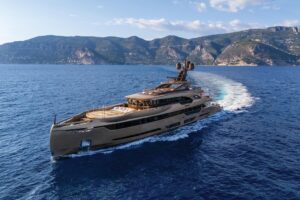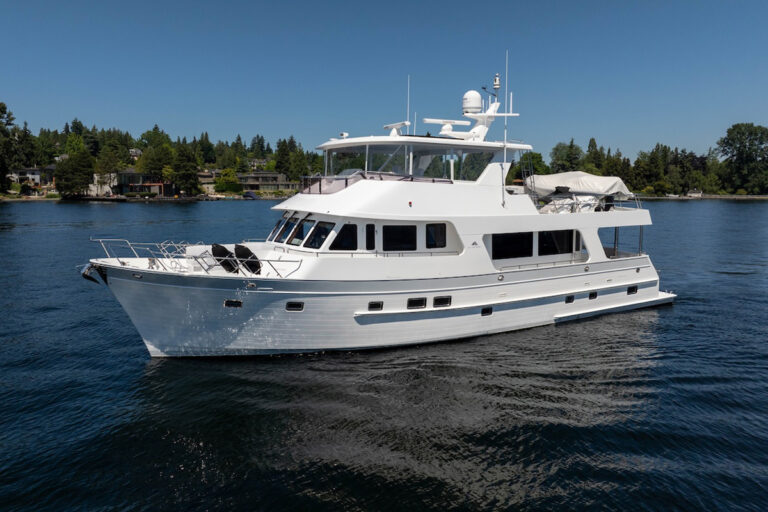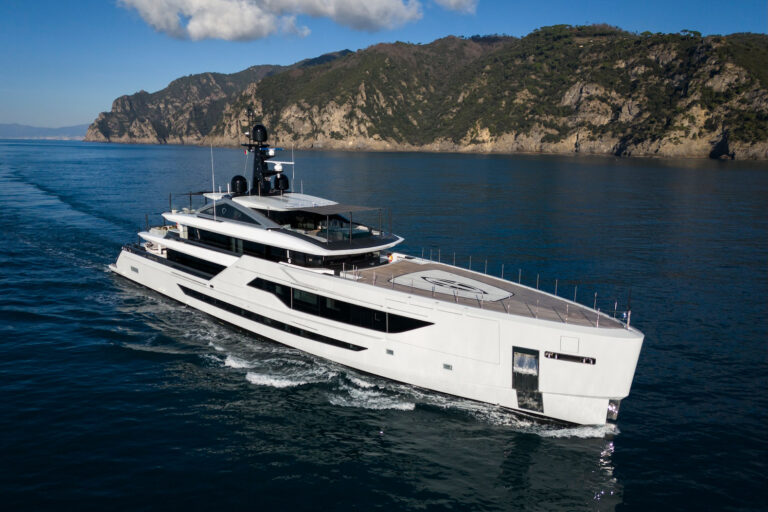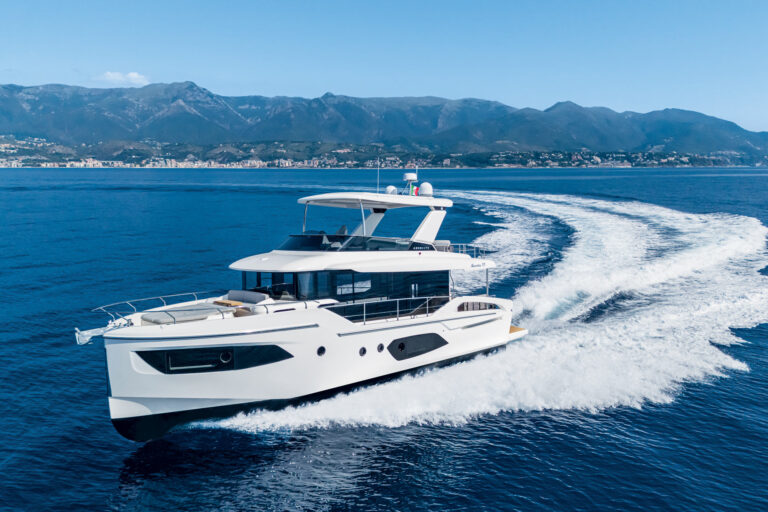Four giant manta rays emerged from the blue gloom like stealth bombers, their enormous pectoral fins flapping gracefully as they glided right into our group of divers. They did not seem to care that we were in their way until the lead manta, realizing there was a strange, bubbling creature in front of it, veered away sharply an arm’s length from me. Even then, the manta seemed only slightly irritated that it had to adjust its flight path. It swam away so slowly I was able to keep up. Unable to contain myself, I grabbed its tail. The pectorals kicked into action, and the manta disappeared. This was what I had come halfway around the world to see.
I was in the Maldives, a secluded collection of sandbar islands about 400 miles southwest of India, spending a few delicious days on board Four Seasons Explorer, a 128-foot catamaran belonging to the Four Seasons Resort Maldives at Kuda Huraa. The highly regarded luxury-hotel chain normally doesn’t sponsor charter yachts, but it made an exception in this case, because the only way to really see the Maldives is by boat. There are nearly 1,200 islands in the archipelago, most so small they can hold only a single resort or tiny town. Since 1968, when the Maldives became a republic, about 100 of the islands have been developed into resorts, many featuring long docks over reefs lined with well-appointed water bungalows. The region also has dozens of large “liveaboard boats catering to scuba divers who find the unexcelled waters worth the long trip. Last year, Four Seasons Explorer began taking guests on tours of the resort near the capital of Malé, bringing the liveaboard option close to the level of a luxurious private yacht.
It is not unusual for Yachting to go far afield in search of an unforgettable experience, but this adventure was a marathon journey-and one definitely worth the effort. The voyage consisted of a three-hour ride from Florida to New York, where I boarded a 20-hour Malaysia Airlines flight to Kuala Lumpur, Malaysia, with a fuel stop in Dubai, United Arab Emirates. During the flight, I was treated to countless movies, four meals, two sunsets and a half-dozen white oshibori. In Asia, the damp hand towels are ubiquitous, presented tightly rolled, piping hot or ice cold, with a pair of tongs. If nothing else, our hands were clean. Then, I had a two-day layover in Kuala Lumpur, where I awaited an infrequent six-hour flight to Malé. I initially bridled at the enforced rest stop, but it gave me a pleasant chance to visit another country and adjust to jet lag.
Malé International Airport is actually on its own nearby island, so just outside the terminal were a pier and dozens of water taxis. I boarded a Four Seasons taxi-and received another oshibori-for the half-hour ride to the resort on Kuda Huraa. I still had to get to the yacht, however, which was 100 miles south of us, so the next morning I boarded a Twin Otter seaplane for the final half-hour leg to Explorer, anchored off the small island of Dhangethi. Through the windows, scattered inside the 26 major atolls that compose this country of fewer than 330,000 residents, we could see the remains of dozens of terrestrial bubbles stretching to the horizon, hot lava spores that had popped eons ago, leaving only rings of sunward-straining coral reefs around their collapsed centers.
Explorer is a wide catamaran with a 40-foot beam, a 5-foot draft, 11 double staterooms and a crew of 23. The staterooms are well designed, with en suite heads, large picture windows and king berths. Ten staterooms are identical; the 11th is a full-beam master on the main deck with windows spanning the room forward. On the afterdeck are a jacuzzi, a number of chaise lounges and even a massage table. The food is first-rate. One can charter Explorer for $12,000 per day (including gratuity), which makes this one of the best private-charter deals for a yacht this size in this part of the world. Except for the guest list, the cruise management and the industrial look of the stern, Explorer could have easily passed muster in the private-yacht category.
Snorkeling is popular, as are sunbathing on the vacant islands Explorer visits and evening picnics on patches of dry sand miles from any real island. A major focus aboard the yacht, however, is scuba diving. The waters of the Maldives are some of the world’s best, with reefs populated by a kaleidoscope of tropical fish more abundant and varied than those even in the fabled Pacific. Explorer comes with two divemasters, two compressors, dozens of tanks and full sets of dive equipment, and a traditional dhony-an open vessel with a high, arched prow native to these waters-which takes divers to the sites. Four inflatables are available for snorkelers and those heading to shore. Unlike many overworked tourist spots in the Caribbean, the places we visited with Explorer were first-rate and unspoiled. One location offered mantas and whale sharks; another specialized in B-29-style formations of eagle rays; huge schools of dolphin frequented still another.
The next afternoon, we piled into inflatables for the trip to Dhangethi. Like most of the inhabited islands, Dhangethi has largely converted from subsistence fishing to tourism, and the sandy main street is lined with tourist shops. In a few minutes I had strolled the length of the street, which ended on the other side of the island. Near the town’s pier was a cultural museum in which girls in native costumes demonstrated the largely disappeared crafts that occupied Maldivians for centuries. They pounded grains in earthenware pots, wove palm-frond tapestries, played ancient games and giggled when the cameras came out.
Only the rustle of palm leaves, the distant drone of the surf and occasional voices broke the silence of the community. No cars were here, of course. A girl held an animated conversation in the town’s only phone booth; a boy on a bicycle swished around a corner; white-uniformed schoolchildren loaded with books chattered among themselves. On a beach at the edge of town, teenaged boys threw fishing lines into the water, emerging with 6-inch snappers. It was the idle pace of island life everywhere.
Every day, Explorer cruised to another choice location. One morning after breakfast, we anchored off the vacant island of Visna Finolhu, where an advance party of crew went ashore to pitch canopies and lay out picnics. We spent a pleasant day on the beach-water skiing, wading among offshore sandbars and swimming in the ultra-aquamarine water. That evening, we watched a crimson sunset during a four-course dinner on the yacht’s open afterdeck. Toward the end of dinner, a half-dozen crew showed up with drums and danced for guests.
Around midmorning on our fourth day, we arrived back at the resort. For the divers, a sojourn on land was necessary-flying within 24 hours of diving can be dangerous. The small size of the islands prohibits huge resort complexes, and this one has only 106 rooms, including the water bungalows over the reef. In 10 minutes you can walk the length of the island. But within the space were all the amenities typical of high-end hotels: a well-appointed gym, a large swimming pool, private sessions with an Indian yogi, a long beach perfect for watching sunsets, three restaurants serving Italian, Asian and Indian cuisine, and Internet access (albeit slow). On a separate, tiny island tended by dhonies was a health spa with 15 masseuses and massage rooms on stilts casting over the water. A window on the floor near the head of each table allowed the damsel fish to look up at customers grimacing from deep-tissue massages.
A friendly concierge showed me to my bungalow. The room was oversized, with a king bed. The bathroom behind included an open-air shower surrounded by potted plants. Outside my front door was a large, cold-water jacuzzi; a few feet beyond, through some hibiscus bushes and small palm trees, was the beach. It was the perfect spot to prepare for the long voyage home.
Contact: Four Seasons Resort Maldives at Kuda Huraa, (011) 960 444 888; res.maldives@fourseasons.com; www.fourseasons.com. Rates vary with length of stay and time of year.For more information, contact: (866) 922-4877; www.yachtingnet.com/yachting/productinfo.








